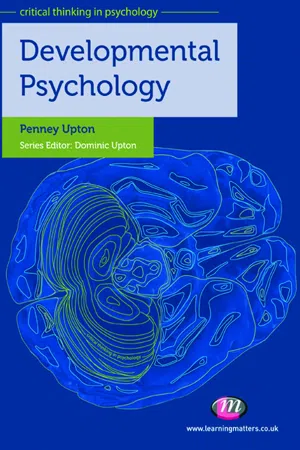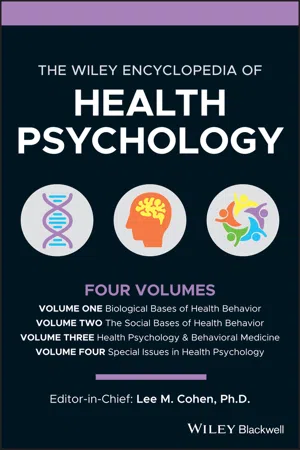Psychology
Prenatal Development
Prenatal development refers to the process of growth and maturation that occurs in an unborn baby from conception to birth. It encompasses the stages of germinal, embryonic, and fetal development, during which the major organs and body systems form and develop. Prenatal development is influenced by genetic factors, maternal health, and environmental influences, and it plays a crucial role in shaping an individual's future physical and psychological well-being.
Written by Perlego with AI-assistance
Related key terms
8 Key excerpts on "Prenatal Development"
- eBook - ePub
- Penney Upton(Author)
- 2011(Publication Date)
- Learning Matters(Publisher)
Chapter 2 Prenatal Development, birth and the neonateLearning outcomes
By the end of this chapter you should:– be able to describe the main stages of Prenatal Development;– understand the factors influencing Prenatal Development;– be able to evaluate how the environment and genetics interact to influence development;– be aware of the main threats to typical Prenatal Development;– be able to evaluate critically the evidence concerning prenatal learning and later cognitive development;– understand critically the importance of social and cultural factors surrounding the birth process;– have developed your ability to analyse and evaluate written text;– have developed your organisational skills and visual communication.Introduction
During the prenatal period, many of the foundations for later development are established. It is therefore important to know what happens during the main stages of Prenatal Development and this is the starting point for this chapter. Physical maturation of the unborn child is described and the genetic factors that influence this early development are presented.However, it is also important to remember that you are studying psychology, not biology. Consideration must be given to the long-term impact of prenatal experiences on later social, emotional and psychological development. For this reason, the focus of Prenatal Development in psychology tends to be on how development may be negatively affected by environmental factors such as teratogens , and on the short- and long-term consequences for child development. Of course, the flip side of this is the way in which avoidance of teratogens can be beneficial for future infant well-being. The sort of advice that could be given to expectant parents in order to give their child the best developmental opportunities should therefore be considered. Other important environmental factors that are discussed include the social and cultural context in which development occurs and, especially, how this might impact on the perinatal experiences of the neonate - eBook - ePub
Child Development
Concepts and Theories
- Jean A. Mercer(Author)
- 2018(Publication Date)
- SAGE Publications Ltd(Publisher)
Typical development does not mean that a baby is necessarily at an average level of growth, because there are normal individual differences in babies, and one who is quite a bit bigger or smaller than the average may still be very much within the normal range, giving no cause for concern. Although the developmental changes in the baby and in Sophia may be affected by environmental factors, and although the support of the environment is needed to maintain life and development, maturation plays the major role in determining how development proceeds. Concepts Specific to the Prenatal Period Prenatal Growth and Development As a baby develops from conception to the time of birth, the mother is also experiencing her own developmental change as her body alters through pregnancy, a period during which she gains weight as her uterus and breasts grow along with the growth of the baby. This is an important period in the mother’s own physical and psychological development, but because the topic of this book is child development, pregnancy will not be the focus here. Instead our concern will be with gestation, the events and processes that change the single cell of a fertilized ovum to the complex, multicellular organism, weighing at least several pounds, that emerges at birth many months after conception. In talking about events during gestation, it can be helpful to use the terms prenatal (referring to the period between conception and birth), perinatal (referring to the time just before, during, and soon after birth), and postnatal (after birth). These terms emphasize the concept of birth as a discontinuity in the process of development, with events before and after birth having somewhat different natures; however, continuity of development, with similar processes at work from the prenatal to the postnatal period and later, is an important theme in the study of child development - Nancy Fenton, Jessica Flitter(Authors)
- 2015(Publication Date)
- Research & Education Association(Publisher)
Chapter 11 Developmental PsychologyDevelopmental psychology focuses on the physical, cognitive, social, and moral development of humans that occurs across the lifespan from conception to death. Typically developmental psychologists examine these various changes at distinct periods in life, in particular, prenatal and newborn, childhood, adolescence, and adulthood. Developmental psychologists are ultimately attempting to answer questions about how we become who we are and how much of whom we are is related to nature and how much is influenced by nurture. In regard to developmental psychology, the term nature specifically references influences on development that are genetic or biological. Aspects of developmental change influenced by nature are often related to the process of maturation. Maturation includes the biological growth processes that enable changes in behavior. These growth processes are connected to an individual’s genetic blueprint, meaning that they are relatively uninfluenced by experience. The term nurture involves the influence of environmental factors on development, such as family, nutrition, culture, interactions with others, education, wealth, etc. Developmental psychologists agree that both nature and nurture contribute to physical, cognitive, social, and moral development in people.STUDY TIPBe able to describe how nature and nurture influence physical, cognitive, social, and moral development.Developmental Research MethodsDevelopmental psychologists seek to understand how individuals develop over time and determine whether differences among age groups are related to changes in cognitive, emotional, or behavioral abilities; for example, if older children can remember longer lists of words than younger children. Because age cannot be manipulated (individuals cannot be randomly assigned to a particular age group), developmental research is often correlational.- eBook - ePub
Brain Research in Education and the Social Sciences
Implications for Practice, Parenting, and Future Society
- Doris Bergen, Joseph Schroer, Michael Woodin(Authors)
- 2017(Publication Date)
- Routledge(Publisher)
The normally developing fetus begins to show motor and sensory activity very early (about seven weeks after gestation), and researchers have hypothesized that this activity aids early brain development (Hofer, 1988). Other brain areas that begin development early in fetal life are the somatosensory system (touch, pain, and temperature sensitivity); the vestibular system (balance and motion); and the visual, auditory, olfactory, and gustatory senses. An area (Wernicke) that involves the capacity for understanding language, which is located between the temporal and parietal lobes (planum temporale), begins to grow larger on the left side of the brain. EEG measures of preterm infants show that by 30 weeks, the two hemispheres of the brain already respond differently to language, with the left hemisphere being specialized for this activity. Memory also begins to show basic brain configurations in the fetal period. The building of the higher brain centers continues throughout pregnancy, and at birth the infant’s neurons number about 100 billion. Although there is now evidence that some neuronal generation occurs after birth, the prenatal period is the primary period for neuronal structural growth.Corn and Bishop (2010) have described some assessment methods used to help physicians understand how well the fetus is developing. For example, ultrasonography is used to chart the developmental progress of the fetus, and risk conditions can begin to be assessed by the first trimester. Blood tests are used if an abnormal ultrasound occurs or if the pregnancy is “high risk.” High-risk conditions include maternal age over 35, family history of birth defects, and a previous child with birth defects. Amniocentesis, which involves gaining a sample of amniotic fluid, is conducted in special circumstances of high-risk pregnancy concern.Impact of Prenatal Genetic/Environmental Interaction
Because brain research has clearly indicated that the prenatal environment affects optimum brain development, one of the first implications of this research is that of “do no harm” (Shore, 1997). It is essential that professionals communicate the need for all women to get early prenatal care. Prenatal influences on brain development include genetic factors (physiology of egg and sperm; genetic transmission, errors, and mutations) and environmental factors (intrauterine environment, maternal illness, maternal stress and self-care behaviors, maternal use of harmful substances). Interactions between genetic and environmental factors begin shortly after conception. Many studies report that prenatal malnourishment, exposure to teratogens (substances such as radiation, lead, nicotine, alcohol, and cocaine), and maternal illness and/or maternal stress can negatively affect specific aspects of early brain development, depending on the time period in which they occur. Specific nutritional deficiencies can be crucial at early stages; for example, a deficiency of folic acid in the first weeks of pregnancy may affect neural tube closure, resulting in spina bifida (Honein et al., 2001). Also, maternal stress has been linked to effects on limbic system development in children. Stress-triggered release of hormones (e.g., corticosteroids, catecholamine) from the hypothalamus-pituitary system may restrict blood flow and interfere with other aspects of brain development. Researchers have found that maternal smoking also negatively affects birth weight and is associated with lower scholastic achievement in children. They recommend programs to help pregnant women curb smoking because that would provide health benefits to both mother and offspring (Agrawal et al., 2010). - eBook - ePub
- (Author)
- 2020(Publication Date)
- Wiley-Blackwell(Publisher)
fetal origins hypothesis, confounding variables prevent these studies from providing definitive proof. Instead, strong causal evidence for PS effects comes primarily from animal experiments. This area of research underscores the importance of delineating the effects and mechanisms of stress during the prenatal period in order to provide the optimal foundation for child development.The goals of this article are to (a) outline the essential features of normal prenatal brain development in humans, (b) review the primary methods for studying brain development, (c) summarize findings on the effects and mechanisms of PS, and (d) consider factors that might buffer against PS and promote resilience. Finally, conclusions are discussed in the context of implications for efforts to support the health of pregnant women and their children.Prenatal Brain Development
Brain development unfolds through a series of complex and dynamic processes involving the interaction of genes and the environment (see Stiles, 2008 ). Human prenatal CNS development is organized into the embryonic period (conception—gestational week [GW] 8) and the fetal period (GW9—birth). The first step in embryonic brain development is the emergence of stem cells called neural progenitor cells at GW2. Through the process of gastrulation, neural progenitors become capable of producing all types of cells for the brain and CNS. Following their transformation, the region of neural progenitor cells is called the neural plate. During GW3, the first brain structure, the neural tube, begins to form. Through the process of neurulation, ridges rise along the sides of the neural plate, arch together, and fuse. Before closure of the tube, the anterior end expands to form three primary brain vesicles that are precursors of the forebrain, midbrain, and hindbrain. By GW8, these subdivide to form five secondary brain vesicles that are the precursors of the medulla, pons, midbrain, diencephalon, and telencephalon. From GW4–8 the embryo grows in size tenfold. During this time of rapid development, neurogenesis, - eBook - ePub
- Patricia Heindel(Author)
- 2016(Publication Date)
- Research & Education Association(Publisher)
During pregnancy, stress is debilitative because it draws blood flow away from the fetus and to the muscles of the mother. This deprives the fetus of oxygen. Adrenalin and cortisol also can pass through the semi-permeable placenta and cause an increase in fetal heart rate. This can cause stunted prenatal growth, low birth weight, and birth complications. Studies suggest that infants born to mothers who were stressed during pregnancy have a heightened reactivity to stress in their own life and a reduced physiological ability to manage stressful conditions. Furthermore, studies have shown that emotional stress during pregnancy predicts anxiety, aggression, anger, and over activity among school-aged children. These effects appear after controlling for things like smoking during pregnancy, low birth weight, postnatal maternal anxiety, and low socioeconomic class.PRENATAL DEVELOPMENTPrenatal Development refers to the period of development from conception to birth and is divided into three stages or trimesters. The first trimester , or germinal period, lasts for the first 13 weeks of pregnancy. The second trimester , or period of the embryo , lasts from the 14th to the 27th week, and the third trimester , or period of the fetus , lasts from the 28th week until birth. The average pregnancy lasts 270 days or 40 weeks.After conception, the zygote repeatedly divides as it travels down the fallopian tube to the uterus where it becomes attached to the uterine wall. If a mother is carrying multiples (twins, triplets, etc.), it is due to one of several possibilities. There are two types of twin pairs, monozygotic (identical twins) and dizygotic (fraternal twins). Monozygotic twins occur when the fertilized ovum divides abnormally creating two developing zygotes. Both zygotes embed into the uterine wall and develop separately. Monozygotic twins have identical genetic endowments. Monozygotic twins are frequently studied by psychologists interested in the nature versus nurture controversy since they share the same genes but have different environmental influences. This research will be discussed in greater detail in Chapter 8 - eBook - ePub
Child and Adolescent Psychology
Typical and Atypical Development
- Stephen von Tetzchner(Author)
- 2018(Publication Date)
- Routledge(Publisher)
Development is transactional during fetal life as well (DiPietro, 2010). Depression and anxiety can lead mothers to smoke and drink more alcohol, substances which can affect the development of the fetus (see p. 93). Mothers with fetuses that are active or have developmental anomalies can experience pregnancy as more stressful. Studies showing increased stress in mothers of children with Down syndrome or cleft palate point in this direction (Drillien and Wilkinson, 1964; Stott, 1973). Such conditions cannot possibly have been triggered by the mother’s emotional state. Furthermore, mothers who are depressed or stressed during pregnancy tend to maintain these states after birth. It is therefore difficult to separate the effects of stress during pregnancy from the consequences of the mother’s stress level and possible interaction problems during the child’s first months of life (Field, 2011; Mulder et al., 2002). It is sometimes argued that experiences during a normal birth can have a profound effect on children’s development and lead to mental problems later in life (Winnicott, 1992). There is no scientific support for such claims and others argue that the powerful forces associated with labor and delivery fulfill an adaptive role that helps the newborn child begin to function independently, and thereby eases the transition from fetus to infant (Hepper, 1992; Ronca and Alberts, 1995). SUMMARY 1 Development begins at conception. The characteristics and abilities of a child at birth emerge as the result of 9 months of development. The germinal period consists of the first 10 days. The 6 weeks following the germinal period are called the embryonic period, while the fetal period lasts until the child is born. 2 Several diseases can affect fetal development. In addition to the mother’s use of alcohol, tobacco and drugs, chemical substances in the environment have also proved to be of importance - eBook - ePub
Human Behavior in the Social Environment
Perspectives on Development and the Life Course
- Anissa Taun Rogers(Author)
- 2022(Publication Date)
- Routledge(Publisher)
Given the extraordinary process of fetal development as well as the many psychosocial factors related to being pregnant, social workers need a thorough, accurate, and broad knowledge base about pregnancy, childbirth, and postnatal considerations. Clients often rely on social workers for decision-making support and basic knowledge on pregnancy because social workers, along with medical professionals, are often among the first professionals with whom clients come into contact after discovering they are pregnant. Social workers can provide a great deal of support and education to clients during this crucial time.Although most of the developmental information presented here is couched in medical and biopsychosocial models, social workers often incorporate information from other theories in their interventions to help understand how pregnancy and fetal development can affect clients on individual, interpersonal, and social levels.Growth Processes from Conception through Birth
The fetal growth and development that take place during the short months of pregnancy are both vast and complex. Although many women experience pregnancies without complications or problems, equipping clients with as much information as possible about fetal development can help to prevent some otherwise devastating problems with their babies. Some of these problems are discussed in more detail in a later section. However, because these problems can occur, social workers must have a basic understanding of fetal development, including anticipated milestones of development as well as biological factors, maternal actions, and environmental conditions that can contribute to health and well-being for all parties involved.Quick Guide 8
Learn about this page
Index pages curate the most relevant extracts from our library of academic textbooks. They’ve been created using an in-house natural language model (NLM), each adding context and meaning to key research topics.







